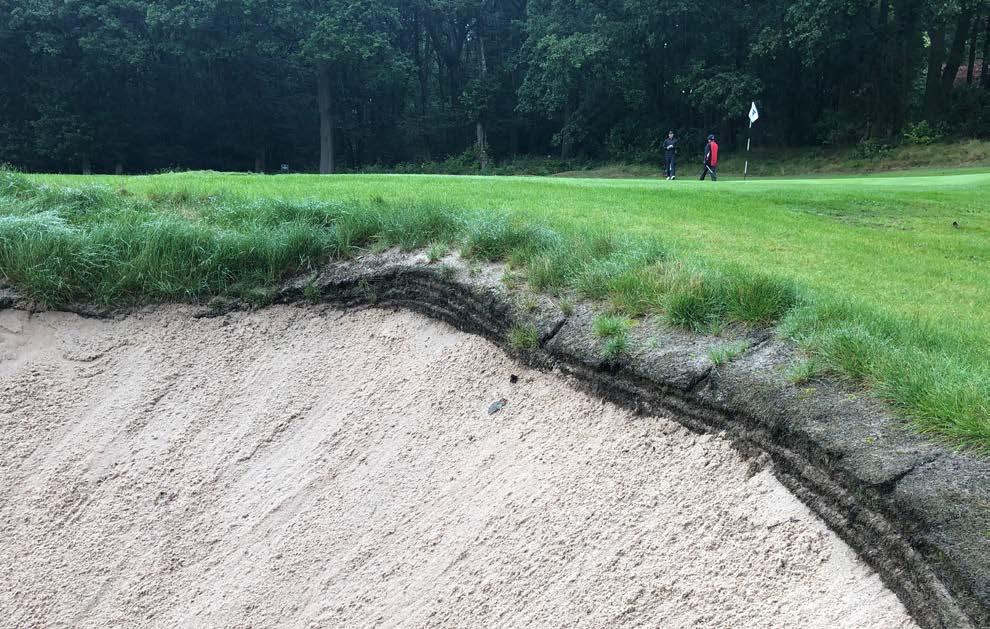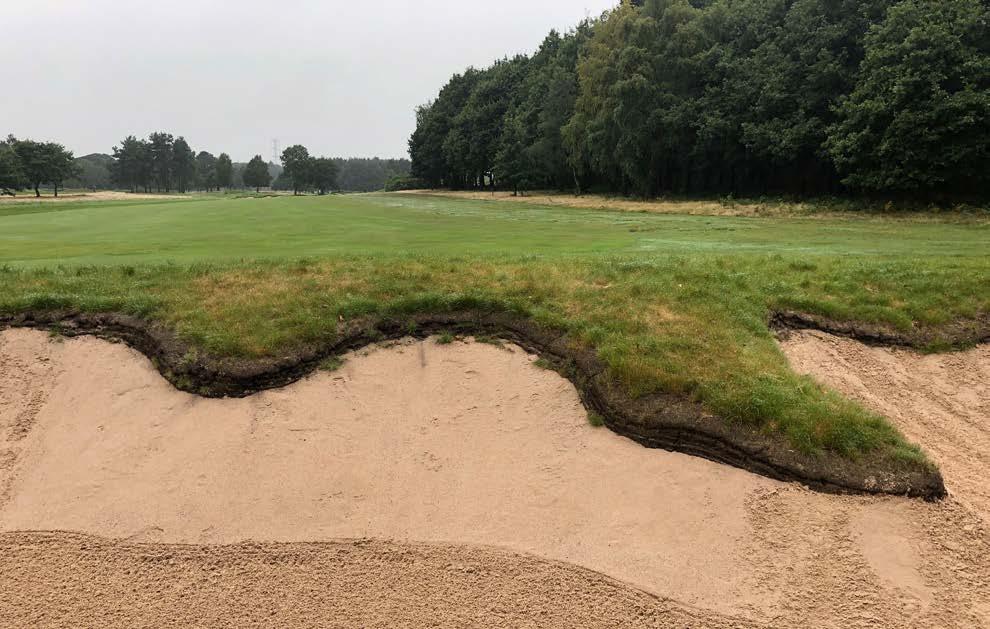
9 minute read
Are fewer bunkers the future of golf?
Why fewer bunkers should be the future FOR GOLF CLUBS
Perhaps the phrase ‘shock and awe’ was really meant for what Bryson DeChambeau did to Winged Foot during September’s US Open.
Advertisement
In dismantling the historic venue with a bludgeoning straight driver and scant regard for the USGA’s feared rough, the ‘Scientist’ once again ignited the debate over distance and how far the ball goes.
And while what goes on at the elite level may not immediately be apparent to those of us whose play never threatens such stratospheric levels, the calls from clubs to relocate hazards and alter teeing areas hasn’t halted since the
days Tiger Woods first forced the game into a radical rethink about length.
But what does this current fad mean for the future of the game, both at the top level and for those wondering how it might filter further down the food chain?
And what are the pressing issues for clubs considering their own golf course renovation projects?
Golf course architect Marc Westenborg has consulted for more than 100 courses, including designing the likes of Rockliffe Hall, which has hosted the English Senior Open on two occasions, and the 27-hole Dun Laoghaire in Ireland, which hosted the Curtis Cup in 2016. Other new builds include Cobh, Carrick-on-Shannon and Gorsty Hill.
He’s completed acclaimed projects at some of Britain’s most venerable existing golf clubs – such as Southport & Ainsdale, Ipswich (Purdis Heath), Moor Park and West Herts in the UK, Dooks, Cork HC and Blainroe in Ireland, Tat Beach in Turkey and The Hong Kong Golf Club.
So, with a background steeped in the highest levels of course design, we asked him to consider two of the hottest topics in the game today – distance and bunkers – and give his views on what could be in store.
We asked the experienced golf course architect Marc Westenborg to weigh in on two big topics dominating the golf world. His answers might surprise you
Distance
The European Institute of Golf Course Architects surveyed their membership and reported three quarters believed increasing ball flight lengths and advances in equipment are diminishing the game. How big a problem is this? I believe this issue is two-fold. For professional golfers, any

further advances in ball and club technology needs to stop now. It’s already reached the point where, with their combination of ability, accuracy and distance of hitting, it has become nearly impossible to design a golf course that reasonably challenges them while, most importantly, ensuring that the remaining 99% of golfers are still able to enjoy a game of golf without being completely humiliated. Therefore, for that reason alone, when designing or renovating golf courses, I try not to overly concern myself with attempting to second guess the ability of professional golfers but rather try to ensure that the average golfer is fairly challenged and has the opportunity to enjoy themselves. I am of the opinion


that most golf courses, new and existing, can be adapted in such a way that their challenge increases for professional tournaments.
Be it fast greens, deep rough, narrow fairways, back tees, and so on.
However with professionals now approaching 350-yards to even 400-yard tee shots, most Par 4 holes become little more than a drive and wedge and this is the point where it becomes increasingly tricky to challenge professionals, no matter how deep the rough. For the amateur golfer, I really do not see the improvement of technology as a problem. Golf is a difficult game and anything that can be done to make it as user friendly as possible should be encouraged – be it balls that fly further or clubs that claim to stop the dreaded “slice”.
As an average golfer myself, there is nothing more satisfying than occasionally hitting a 250-yard+ tee shot and I know from bitter experience that this by no means guarantees a good score by the time I walk off the green.
If amateur golfers want to hit the ball further, this is fine by me. Some might argue that technology is forcing clubs to adjust the position of fairway bunkers, and to a certain extent this is true. However, I visit and play a lot of golf courses and one would be surprised that even bunkers positioned seemingly too close to the tee at around 200-yards are actually quite well positioned for a high proportion of golfers at private members’ clubs, mainly due to their age demographic.
However, especially bearing in mind improved technology, the longer hitters must also be considered and this is where, if possible, back tees play an important role as well as careful positioning of the bunkers.
Needless to say, it is a hugely complicated process. Every situation is different and it is nearly impossible to satisfy everyone.
What’s the solution? What’s the answer? I’m not too sure there is one, nor am I convinced that, apart from ensuring that club and ball technology has now reached its pinnacle, anything too drastic needs to be done. The work that is already carried out before the professional tournament seems reasonable to me; fast greens with some challenging pin locations, maximising the yardage of the golf course, and thick rough combined with narrow fairways being some of the measures that are put into place. Apart from reducing the capability of ball distance by the 15% I have heard talked about, there is little else. And would that 15% make that much difference? At the most a two-club change to the approach – a 6-iron instead of an 8-iron perhaps.
Professional golfers are so talented, I question whether this would really have a massive influence on final scores and, at the end of the day, it is more likely that the amateur golfer will be punished. The term “Tiger Proofing” is often mentioned. But what exactly are we trying to achieve? Are we trying to stop professional golfers achieving under par scores or do we gain enjoyment seeing them struggling around a golf course? I don’t think so and, for the most part, the crowds want to see long drives, birdies and eagles.
Without doubt it’s a hugely complicated issue but I don’t think it is quite as big a problem as some people make out. I am much more relaxed about this than some – just so long as we have now reached a pinnacle of ball and club technology.
Bunkers
You mentioned bunkers. Given the money and maintenance needed to keep them in good repair, do clubs need to think about the numbers they have? Reducing the number of bunkers on golf courses, while ensuring those that remain are built to the highest possible design and construction specification, is very much the trend at the moment. Bunker liner technology has improved markedly these past few years and there are now some excellent rubber, concrete and material based products which are effective in extending the life of the drainage as well as, in some cases, helping to reduce wash-outs of high sand faces.
Removing bunkers is not quite as simple as it first appears. Not only does the strategic values of the hole have to be considered,

especially bearing in mind the discussions earlier regarding improved technology but, also very importantly, the visual elements of the golf hole. I tend to find that it is mostly greenside bunkers that can be removed, especially those towards the back of greens that are hidden from view by more forward bunkers.
In these instances, the bunkers can be replaced with grass hollows, swales, ridges or mounds that can be equally as effective a hazard and considerably cheaper to maintain. Upgrading the bunkers also provides the club with an excellent opportunity to adjust the location of fairway and approach bunkers and, overall, a bunker renovation project can have a dramatic positive impact on the success and long-term sustainability of a golf course.
Is it difficult to convince clubs of that approach? It’s extremely difficult to convince clubs. When I start talking about the figures that might be involved in a full bunker renovation project, including the liners, it is ‘wow’. We are talking £100,000 or £200,000 including the drainage, turf and fresh sand. Clubs say ‘how are we ever going to see our money back on that?’ To all intents and purposes, though, everyone I speak to says ‘the amount of work the maintenance crew are having to do in the bunkers is massively reduced’, as a result and this has the knock on effect of not only saving money, but also allows the maintenance crew to spend more time on other areas of the golf course - resulting in an overall raising of the golf course standards. This, in turn, has the knock-on effect of retaining existing members, generating new members and, although difficult to
quantify, without doubt will result in a return in investment within a few years. Additionally, the costs mentioned, normally includes all the work being carried out by a golf course contractor. Considerable savings are possible if the maintenance crew become actively involved in the construction process and I always encourage this - not just to save money, but to make sure everyone feels part of the process. However, it is important professional architects and constructors are commissioned. It may be possible to do all the work in-house, but it is risky and I have seen many disasters. Renovating bunkers is a far more complicated process than initially meets the eye.
The future
How do you see the future?

Despite all the problems, I am positive about the future of golf. Hundreds of golf courses have recently closed and, although sad to see, this has had the knock-on effect of improving the viability of those golf courses that have remained open. The main issue is ensuring there is a constant supply of new golfers. I often hear golfers say that, because of the age profile of many clubs, all the golfers are dying off and with it the game. This is, of course, not true because at the same time new golfers are taking up the game.
There is a huge amount of work being done to encourage young people to take up golf; the Golf Foundation being an excellent example. There is, however, a lot of competition from other, possibly more easily accessible, sports and there may be a period of time during which young golfers give up golf. However, eventually, even if it is not until they are 50, because they have been already introduced to the game, most will take it up again when their personal circumstances allow, ensuring a fairly constant supply of new golfers. However, it is the responsibility of golf clubs to make available facilities to help grow the game – more in the way of practice areas, as well as pitch and putt or Par 3 courses are required.
Added to that, changes in the format of the game, future golf club/developer relationships, the benefits of soil importation that more and more clubs are realising, clubs expanding their revenue stream through nongolfing enterprises (weddings, conferences, etc), as well as what seems to be a vibrant professional scene, all adds up to what I think is a very positive future for golf.
For more information, visit Marc’s website at westenborggolf.com






